On the Stability of Particle–Particle Interaction during Gravitational Settling
Abstract
1. Introduction
2. Materials and Methods
2.1. Materials
2.2. Experimental Apparatus
2.3. Testing Parameters
2.4. Data Analysis and Processing
3. Results and Discussion
3.1. Results in Pure Water
3.2. Results in Glycerin–Water Mixture
4. Conclusions
Author Contributions
Funding
Data Availability Statement
Conflicts of Interest
References
- Ahmed, K.; Ozturk, I. What new technology means for the energy demand in China? A sustainable development perspective. Environ. Sci. Pollut. Res. 2018, 25, 29766–29771. [Google Scholar] [CrossRef] [PubMed]
- Shah, K.U. Potential clean energy transition pathways in the U.S. Virgin Islands using carbon sensitive policy options. Energy Sustain. Dev. 2022, 71, 89–103. [Google Scholar] [CrossRef]
- Paramati, S.R.; Shahzad, U.; Doğan, B. The role of environmental technology for energy demand and energy efficiency: Evidence from OECD countries. Renew. Sustain. Energy Rev. 2022, 153, 111735. [Google Scholar] [CrossRef]
- U.S. Energy Facts Explained—Consumption and Production—U.S. Energy Information Administration (EIA). Available online: https://www.eia.gov/energyexplained/us-energy-facts (accessed on 17 January 2022).
- Zou, G.; Zhang, G.; Tao, S.; Hu, S.; Li, X.; Li, J.; Dong, D.; Zhu, R.; Yuan, X.; Hou, L.; et al. Geological Features, Major Discoveries and Unconventional Petroleum Geology in the Global Petroleum Exploration. Pet. Explor. Dev. 2010, 37, 129–145. [Google Scholar] [CrossRef]
- Klasic, M.; Schomburg, M.; Arnold, G.; York, A.; Baum, M.; Cherin, M.; Cliff, S.; Kavousi, P.; Miller, A.T.; Shajari, D.; et al. A review of community impacts of boom-bust cycles in unconventional oil and gas development. Energy Res. Soc. Sci. 2022, 93, 102843. [Google Scholar] [CrossRef]
- Gargiulo, M.; Chiodi, A.; de Miglio, R.; Simoes, S.; Long, G.; Pollard, M.; Gouveia, J.P.; Giannakidis, G. An Integrated Planning Framework for the Development of Sustainable and Resilient Cities—The Case of the InSMART Project. Procedia Eng. 2017, 198, 444–453. [Google Scholar] [CrossRef]
- Hosseini, S.H.; Shakouri, G.H.; Kazemi, A. Oil price future regarding unconventional oil production and its near-term deployment: A system dynamics approach. Energy. 2021, 222, 119878. [Google Scholar] [CrossRef]
- Chew, K.J. The Future of Oil: Unconventional Fossil Fuels. Philos. Trans. R. Soc. A Math. Phys. Eng. Sci. 2014, 372, 20120324. [Google Scholar] [CrossRef]
- Boak, J.; Kleinberg, R. Shale Gas, Tight Oil, Shale Oil and Hydraulic Fracturing. In Future Energy: Improved, Sustainable and Clean Options for Our Planet; Elsevier Science: Amsterdam, The Netherlands, 2020; pp. 67–95. [Google Scholar] [CrossRef]
- Jiao, F. Re-recognition of “unconventional” in unconventional oil and gas. Pet. Explor. Dev. 2019, 46, 847–855. [Google Scholar] [CrossRef]
- Wang, H.; Ma, F.; Tong, X.; Liu, Z.; Zhang, X.; Wu, Z.; Li, D.; Wang, B.; Xie, Y.; Yang, L. Assessment of Global Unconventional Oil and Gas Resources. Pet. Explor. Dev. 2016, 43, 925–940. [Google Scholar] [CrossRef]
- Mahmud, H.B.; Ermila, M.; Bennour, Z.; Mahmud, W.M.; Mahmud, H.B.; Ermila, M.; Bennour, Z.; Mahmud, W.M. A Review of Fracturing Technologies Utilized in Shale Gas Resources. In Emerging Technologies in Hydraulic Fracturing and Gas Flow Modelling; IntechOpen: London, UK, 2020. [Google Scholar] [CrossRef]
- Robbins, K. Awakening the Slumbering Giant: How Horizontal Drilling Technology Brought the Endangered Species Act to Bear on Hydraulic Fracturing. Case West. Reserve Law Rev. 2013, 63, 4. [Google Scholar]
- Hassett, K.; Forum, A.M.-O.E. Benefits of Hydraulic Fracking. 2013. Available online: https://ora.ox.ac.uk (accessed on 17 January 2022).
- Kroepsch, A.C. Horizontal Drilling, Changing Patterns of Extraction, and Piecemeal Participation: Urban Hydrocarbon Governance in Colorado. Energy Policy 2018, 120, 469–480. [Google Scholar] [CrossRef]
- Danso, D.K.; Negash, B.M.; Ahmed, T.Y.; Yekeen, N.; Omar Ganat, T.A. Recent Advances in Multifunctional Proppant Technology and Increased Well Output with Micro and Nano Proppants. J. Pet. Sci. Eng. 2021, 196, 108026. [Google Scholar] [CrossRef]
- Wang, J.; Elsworth, D. Role of Proppant Distribution on the Evolution of Hydraulic Fracture Conductivity. J. Pet. Sci. Eng. 2018, 166, 249–262. [Google Scholar] [CrossRef]
- Barbati, A.C.; Desroches, J.; Robisson, A.; McKinley, G.H. Complex Fluids and Hydraulic Fracturing. Annu. Rev. Chem. Biomol. Eng. 2016, 7, 415–453. [Google Scholar] [CrossRef] [PubMed]
- McMechan, D.E.; Shah, S.N. Static Proppant-Settling Characteristics of Non-Newtonian Fracturing Fluids in a Large-Scale Test Model. SPE Prod. Eng. 1991, 6, 305–312. [Google Scholar] [CrossRef]
- Ahmad, F.A.; Miskimins, J.L. Proppant Transport and Behavior in Horizontal Wellbores Using Low Viscosity Fluids. In Proceedings of the SPE Hydraulic Fracturing Technology Conference and Exhibition, The Woodlands, TX, USA, 5–7 February 2019. [Google Scholar] [CrossRef]
- Liang, F.; Sayed, M.; Al-Muntasheri, G.A.; Chang, F.F.; Li, L. A Comprehensive Review on Proppant Technologies. Petroleum 2016, 2, 26–39. [Google Scholar] [CrossRef]
- Yu, W.; Zhang, T.; Du, S.; Sepehrnoori, K. Numerical Study of the Effect of Uneven Proppant Distribution between Multiple Fractures on Shale Gas Well Performance. Fuel 2015, 142, 189–198. [Google Scholar] [CrossRef]
- Tong, S.; Mohanty, K.K. Proppant Transport Study in Fractures with Intersections. Fuel 2016, 181, 463–477. [Google Scholar] [CrossRef]
- Tan, Y.; Pan, Z.; Liu, J.; Feng, X.T.; Connell, L.D. Laboratory Study of Proppant on Shale Fracture Permeability and Compressibility. Fuel 2018, 222, 83–97. [Google Scholar] [CrossRef]
- Bulova, M.; Nosova, K.; Willberg, D.; Lassek, J. Benefits of the Novel Fiber-Laden Low-Viscosity Fluid System in Fracturing Low-Permeability Tight Gas Formations. In Proceedings of the SPE Annual Technical Conference and Exhibition, San Antonio, TX, USA, 24–27 September 2006; Volume 5, pp. 3479–3486. [Google Scholar] [CrossRef]
- Cui, C.; Wang, Z.; Wu, Z.; Cheng, X.; Ye, Y. Comprehensive Proppant Settling Model in Hydraulic Fractures of Unconventional Gas Reservoir Considering Multifactorial Influence. Arab. J. Geosci. 2020, 13, 1–8. [Google Scholar] [CrossRef]
- Sahai, R.; Moghanloo, R.G. Proppant Transport in Complex Fracture Networks—A Review. J. Pet. Sci. Eng. 2019, 182, 106199. [Google Scholar] [CrossRef]
- Yao, S.; Chang, C.; Hai, K.; Huang, H.; Li, H. A Review of Experimental Studies on the Proppant Settling in Hydraulic Fractures. J. Pet. Sci. Eng. 2021, 208, 109211. [Google Scholar] [CrossRef]
- Montgomery, C. Fracturing Fluids. In Proceedings of the ISRM International Conference for Effective and Sustainable Hydraulic Fracturing, Brisbane, Australia, 20–22 May 2013. [Google Scholar] [CrossRef]
- Daneshy, A.A. Numerical Simulation of Sand Transport in Hydraulic Fracturing. J. Pet. Technol. 1978, 30, 132–140. [Google Scholar] [CrossRef]
- Clark, P.E.; Manning, F.S.; Quadir, J.A.; Guler, N. Prop Transport in Vertical Fractures. Proc. In Proceedings of the SPE Annual Technical Conference and Exhibition, San Antonio, TX, USA, 4–7 October 1981. [Google Scholar] [CrossRef]
- Gadde, P.B.; Liu, Y.; Norman, J.; Bonnecaze, R.; Sharma, M.M. Modeling Proppant Settling in Water-Fracs. Proc. In Proceedings of the SPE Annual Technical Conference and Exhibition, Houston, TX, USA, 26–29 September 2004; pp. 373–382. [Google Scholar] [CrossRef]
- Joseph, D.D.; Liu, Y.J.; Poletto, M.; Feng, J. Aggregation and Dispersion of Spheres Falling in Viscoelastic Liquids. J. Non-Newton. Fluid Mech. 1994, 54, 45–86. [Google Scholar] [CrossRef]
- Kim, I.; Elghobashi, S.; Sirignano, W.A. Three-Dimensional Flow over Two Spheres Placed Side by Side. J. Fluid Mech. 1993, 246, 465–488. [Google Scholar] [CrossRef]
- Liu, J.; Zhang, P.; Xiao, Y.; Wang, Z.; Yuan, S.; Tang, H. Interaction between Dual Spherical Particles during Settling in Fluid. Phys. Fluids 2021, 33, 013312. [Google Scholar] [CrossRef]
- Cheng, N.S. Formula for the Viscosity of a Glycerol−Water Mixture. Ind. Eng. Chem. Res. 2008, 47, 3285–3288. [Google Scholar] [CrossRef]
- Volk, A.; Kähler, C.J. Density Model for Aqueous Glycerol Solutions. Exp. Fluids 2018, 59, 75. [Google Scholar] [CrossRef]
- Wu, J.; Manasseh, R. Dynamics of Dual-Particles Settling under Gravity. Int. J. Multiph. Flow 1998, 24, 1343–1358. [Google Scholar] [CrossRef]
- Tomac, I.; Tartakovsky, D.M. Experimental Evaluation of Turbulent Flow and Proppant Transport in a Narrow Fracture. In Proceedings of the 43rd Workshop on Geothermal Reservoir Engineering, Stanford, CA, USA, 12–14 February 2018. [Google Scholar]
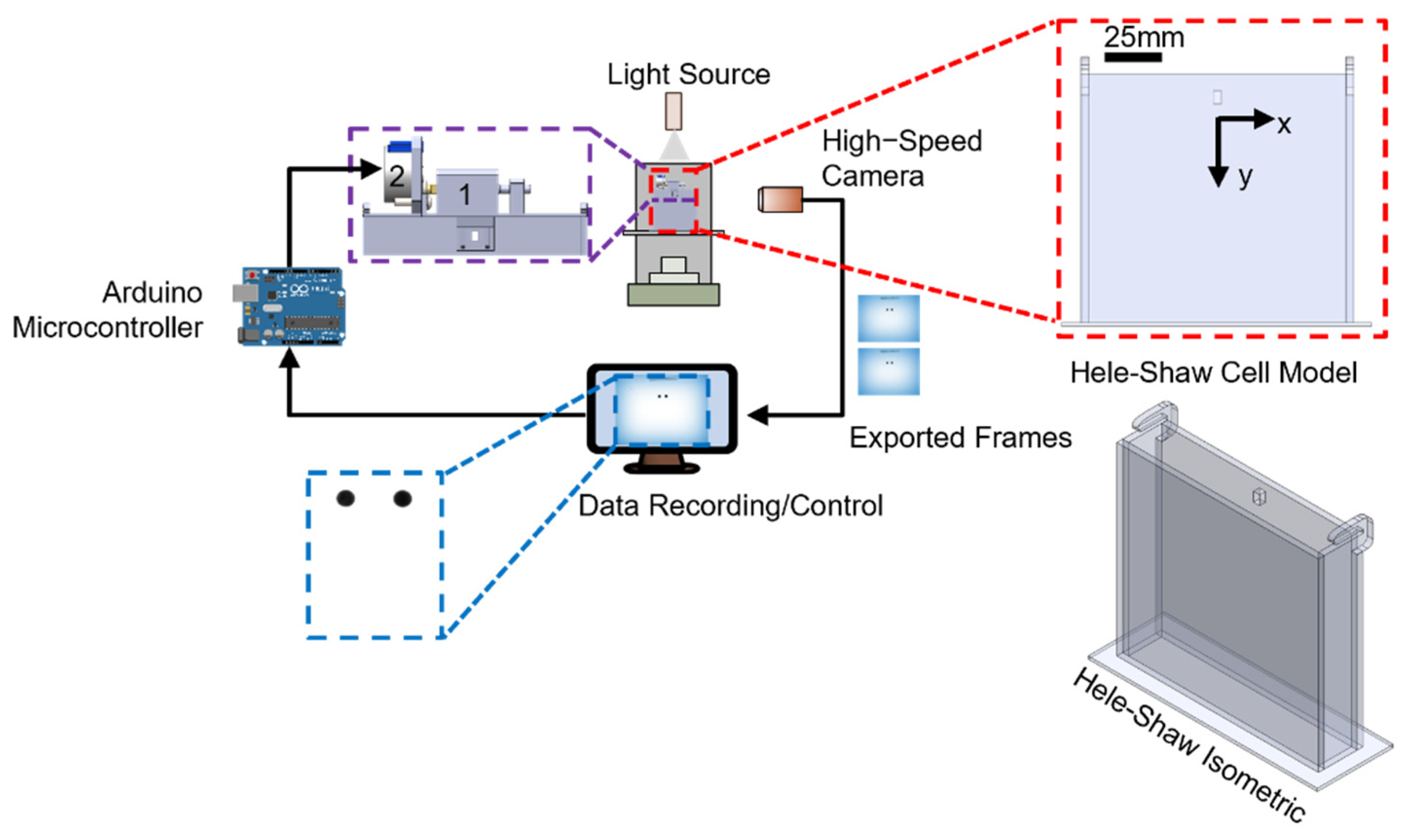

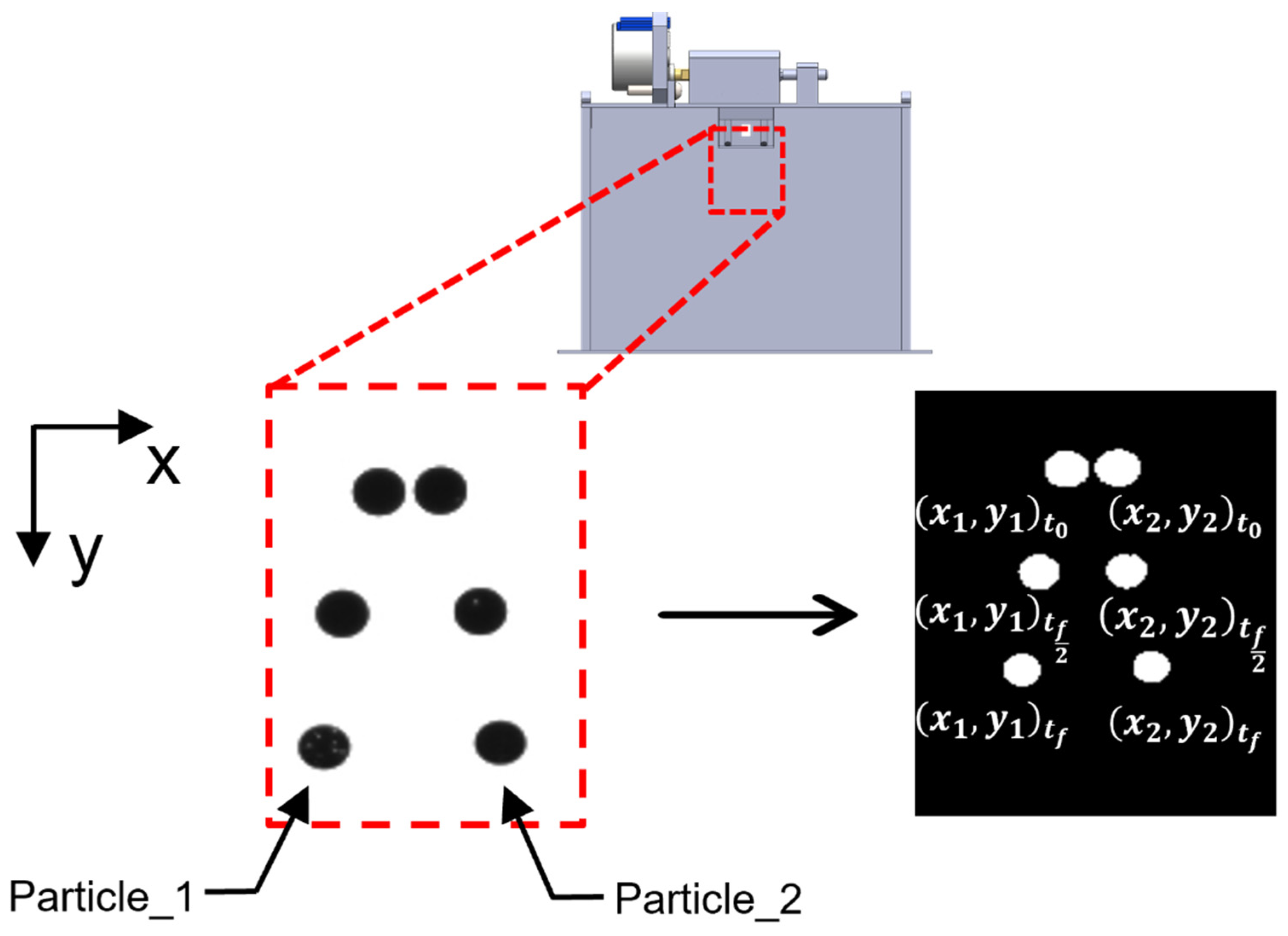

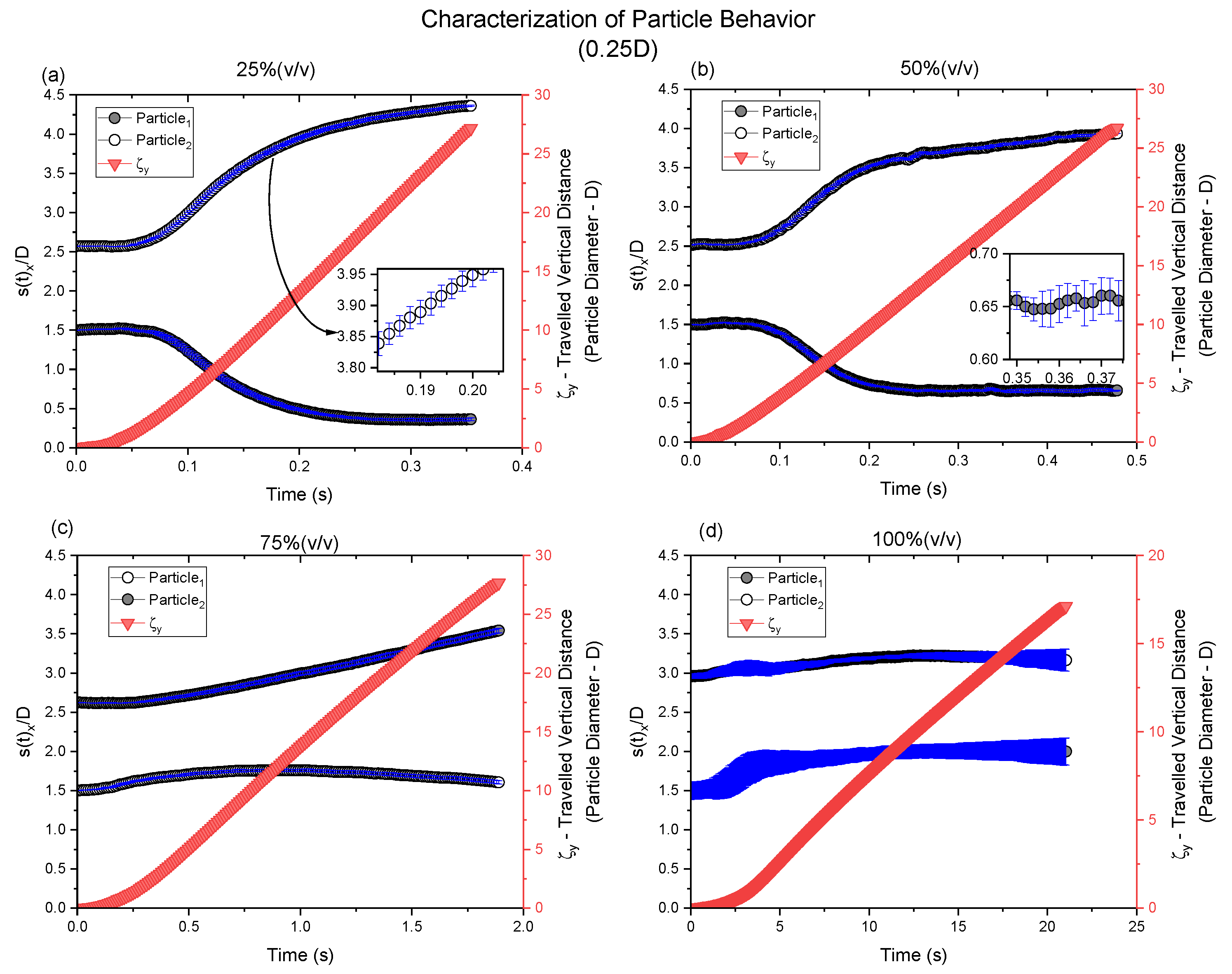

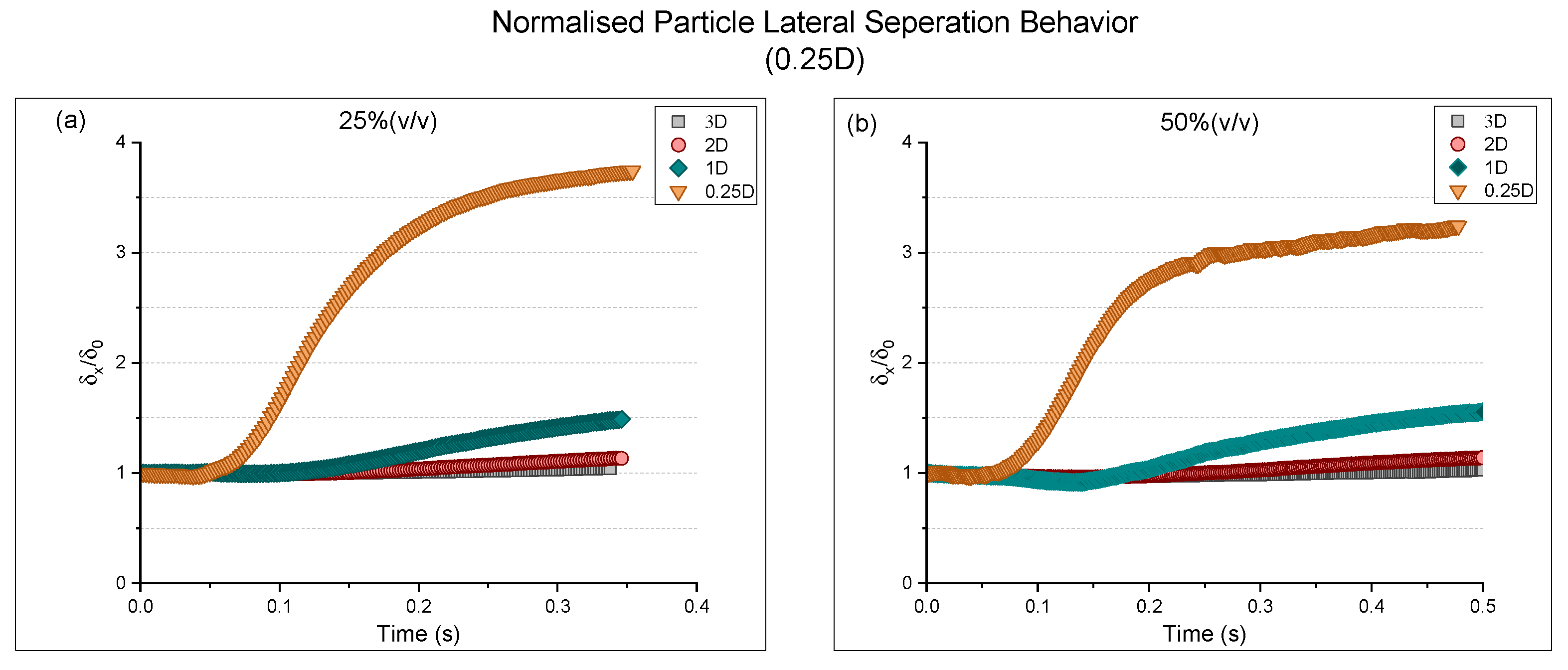
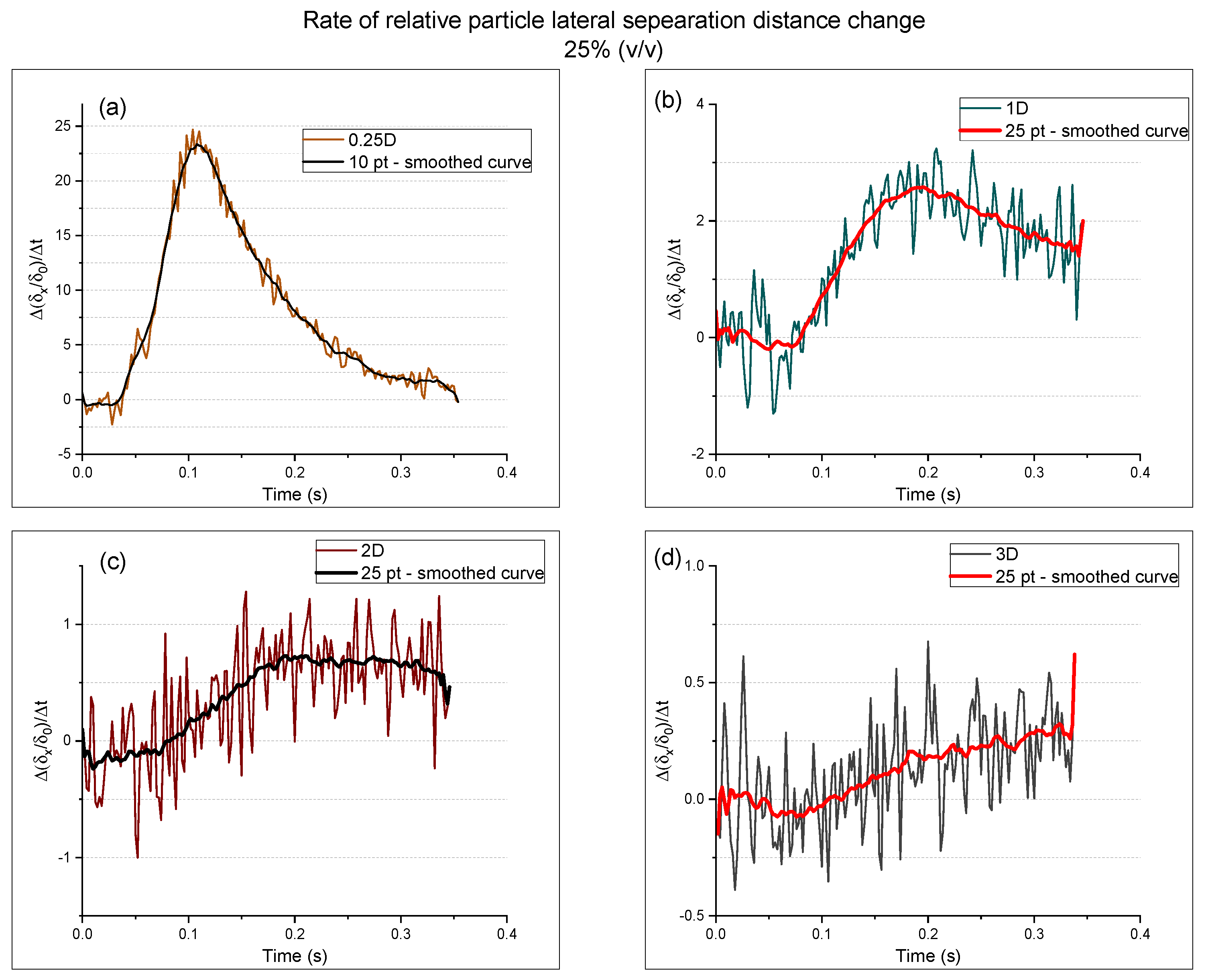
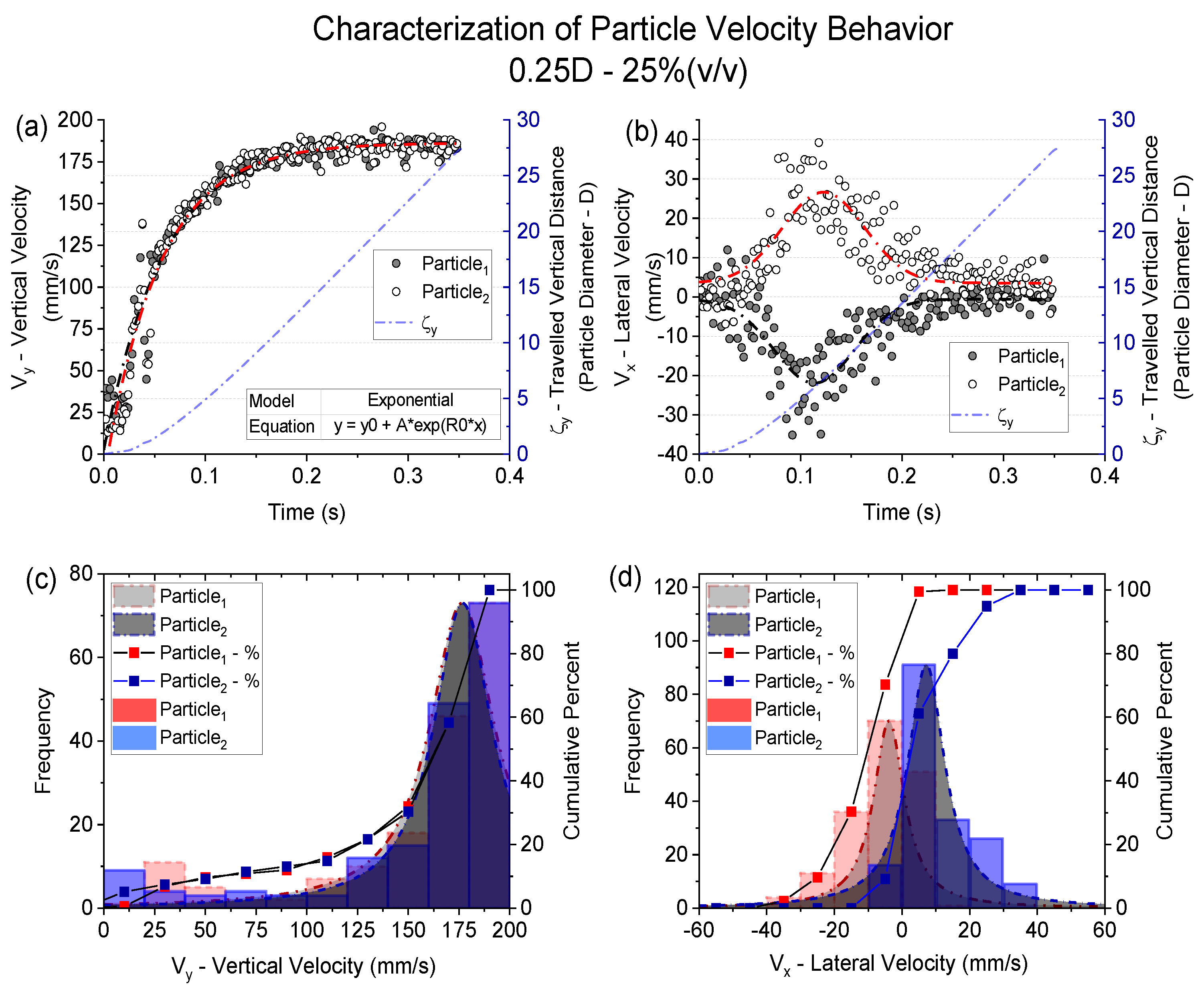
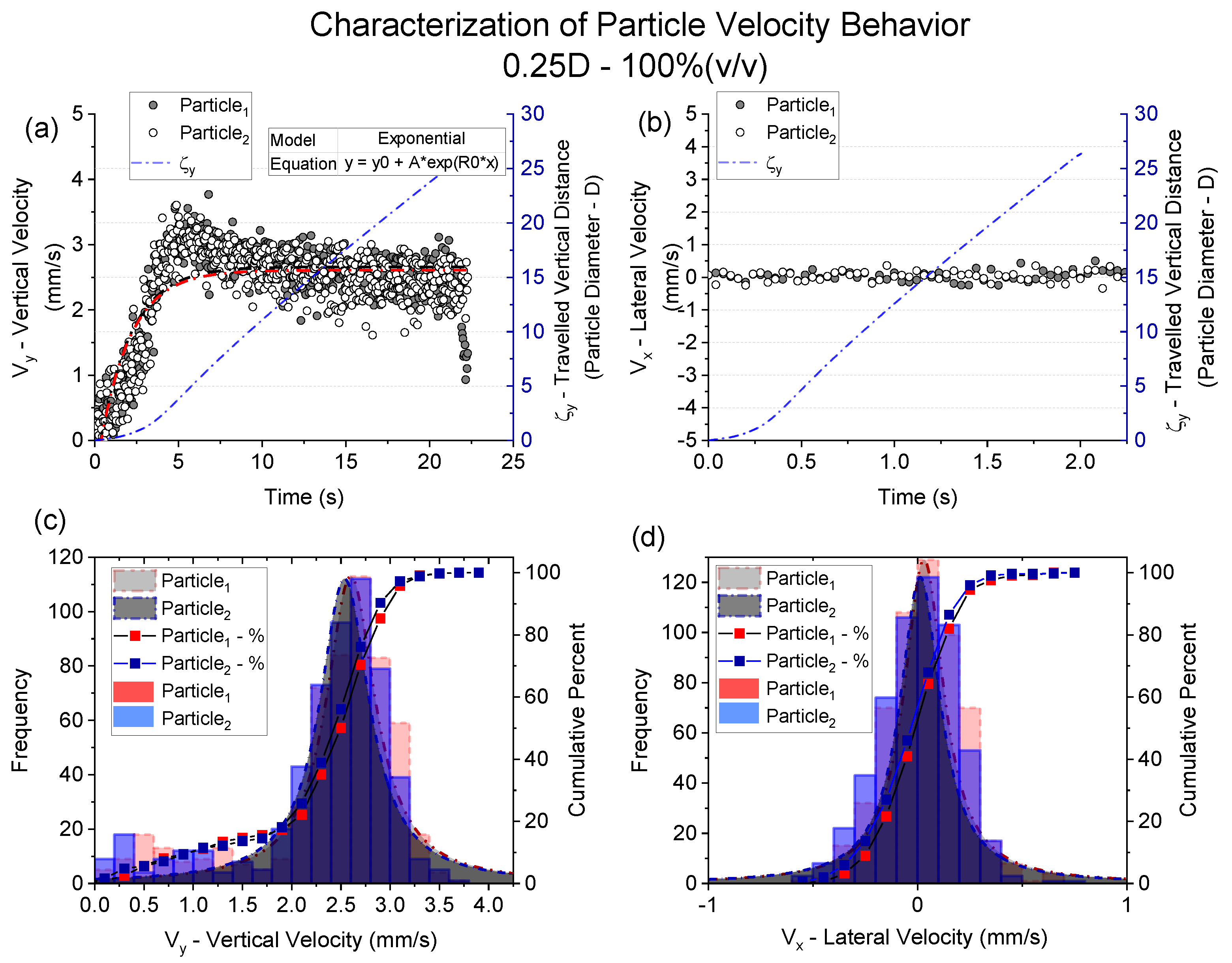
| Concentration | Viscosity | Density | Averaged Settling Velocity | Averaged Particle Reynolds Number |
|---|---|---|---|---|
| 100 | 1.414 | 1260.8 | 2.6 | <<1 |
| 75 | 0.055 | 1205.5 | 32.7 | 1 |
| 50 | 0.008 | 1142.0 | 122.8 | 45 |
| 25 | 0.002 | 1071.5 | 186.6 | 200 |
| 0 | 0.001 | 998.1 | 234.9 | 469 |
Publisher’s Note: MDPI stays neutral with regard to jurisdictional claims in published maps and institutional affiliations. |
© 2022 by the authors. Licensee MDPI, Basel, Switzerland. This article is an open access article distributed under the terms and conditions of the Creative Commons Attribution (CC BY) license (https://creativecommons.org/licenses/by/4.0/).
Share and Cite
Hafez, M.; Ghazvini, M.; Kim, M. On the Stability of Particle–Particle Interaction during Gravitational Settling. Energies 2022, 15, 8721. https://doi.org/10.3390/en15228721
Hafez M, Ghazvini M, Kim M. On the Stability of Particle–Particle Interaction during Gravitational Settling. Energies. 2022; 15(22):8721. https://doi.org/10.3390/en15228721
Chicago/Turabian StyleHafez, Mazen, Mahyar Ghazvini, and Myeongsub Kim. 2022. "On the Stability of Particle–Particle Interaction during Gravitational Settling" Energies 15, no. 22: 8721. https://doi.org/10.3390/en15228721
APA StyleHafez, M., Ghazvini, M., & Kim, M. (2022). On the Stability of Particle–Particle Interaction during Gravitational Settling. Energies, 15(22), 8721. https://doi.org/10.3390/en15228721







